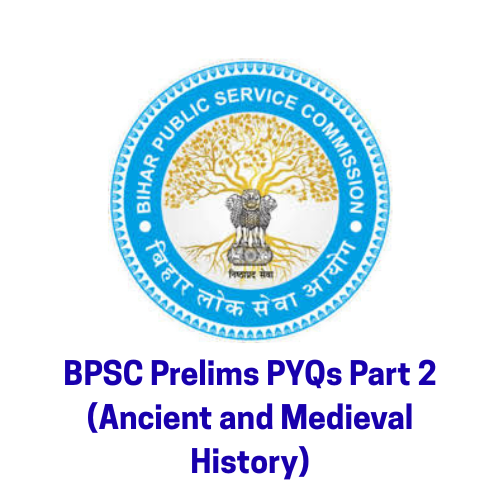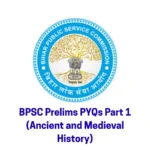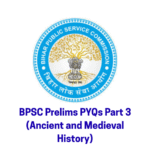BPSC Prelims Previous Year Paper (PYQs) from Ancient and Medieval History form a crucial part of the preparation strategy. Previous Year questions usually test candidates on factual knowledge, important dynasties, cultural developments, and major events.
- Medieval History: PYQs focus on Delhi Sultanate, Mughal Empire, regional kingdoms, Bhakti and Sufi movements, art and architecture, and administrative systems. Bihar’s medieval history, including the role of Sher Shah Suri, is frequently highlighted.
BPSC Prelims PYQs Part 2
Q1.Tughril Khan raised a standard of revolt during whose reign?
(a) Alauddin Khilji
(b) Feroz Tughlaq
(c) Khizr Khan
(d) Balban
(e) None of the above/More than one of the above
Ans. (d) Balban
Q2.Who was the first Mughal ruler fought against the British?
(a) Aurangzeb
(b) Shah Jahan
(c) Bahadur Shah Zafar
(d) Jahangir
(e) None of the above/More than one of the above
Ans. (a) Aurangzeb
Q3.Which of the following Harappan sites is in Gujarat?
(a) Lothal
(b) Dabarkot
(c) Kalibangan
(d) Rakhigarhi
(e) None of the above/More than one of the above
Ans. (a) Lothal
Q4.Who was the founder of the Chola Dynasty?
(a) Vijayalaya
(b) Karikala
(c) Aditya I
(d) Rajaraja 1
(e) None of the above/More than one of the above
Ans. (a) Vijayalaya
Q5.Who wrote the book, “Kiratarjuniya”?
(a) Bhatti
(b) Shudraka
(c) Kalidasa
(d) Bharavi
(e) None of the above/More than one of the above
Ans. (d) Bharavi
Ancient and Medieval History PYQs
Q6.The Qutub Minar was completed by
(a) Iltutmish
(b) Qutb-ud-din–Aibak
(c) Ulugh Khan
(d) Raziya Sultana
(e) None of the above/More than one of the above
Ans. (a) Iltutmish
Q7.Who was the founder of the Vijayanagara Empire?
(a) Deva Raya I
(b) Krishnadeva Raya
(c) Harihara-Bukka
(d) Vira Narasimha Raya
(e) None of the above/More than one of the above
Ans. (c) Harihara-Bukka
Q8.During the time of which Mughal Emperor did “Sir Thomas Roe” come to India?
(a) Babur
(b) Akbar
(c) Jahangir
(d) Shah Jahan
(e) None of the above/More than one of the above
Ans. (c) Jahangir
Q9.Ain-i-Akbari was written by
(a) Abdul Qadir
(b) Akbar
(c) Khwaja Nizamuddin
(d) Abul Fazl
(e) None of the above/More than one of the above
Ans. (d) Abul Fazl
Q10.The first Human Fossil was found from which river valley of India?
(a) Ganga Valley
(b) Yamuna Valley
(c) Narmada Valley
(d) Tapti Valley
(e) None of the above/More than one of the above
Ans. (c) Narmada Valley
BPSC Prelims PYQs Part 2 (Q11 to 20)
Q11.The first Empire was established by which ruler in India?
(a) Chandragupta Maurya
(b) Ashoka
(c) Kanishka
(d) Chandragupta II Vikramaditya
(e) None of the above/More than one of the above
Ans. (a) Chandragupta Maurya
Q12.The Oldest sculpture of Buddha is made in which style?
(a) Gandhara style
(b) Mathura Style
(c) Mauryan Style
(d) Gupta Style
(e) None of the above/More than one of the above
Ans. (a) Gandhara style
Q13.In which Inscription, Kalinga victory is mentioned?
(a) Maski Inscription
(b) Rudradaman Inscription
(c) Junagarh Inscription
(d) Hathigumpha Inscription
(e) None of the above/More than one of the above
Ans. (e) None of the above/More than one of the above
Q14.Who started “Public Distribution System” in Sultanate period?
(a) Alauddin Khalji
(b) Sikander Lodhi
(c) Mohammad Bin Tughlaq
(d) Firoz Shah Tughlaq
(e) None of the above/More than one of the above
Ans. (a) Alauddin Khalji
Q15.Which famous war took place in 1565 AD?
(a) Panipat I War
(b) Panipat II War
(c) Khanwa War
(d) Talikota War
(e) None of the above/More than one of the above
Ans. (d) Talikota War
Ancient and Medieval History PYQs
Q16.Who promulgated “Din-e-Illahi”?
(a) Babar
(b) Akbar
(c) Jahangir
(d) Shah Jahan
(e) None of the above/More than one of the above
Ans. (b) Akbar
Q17.Ashta Pradhan was helping in administration of which ruler?
(a) Akbar
(b) Krishnadeva Raya
(c) Shivaji
(d) Shershah
(e) None of the above/More than one of the above
Ans. (c) Shivaji
Q18.In which of the following Harappan cities, furrows of ploughed fields have been found?
(a) Kalibangan
(b) Dholavira
(c) Mohenjo-daro
(d) Lothal
(e) None of the above/More than one of the above
Ans. (a) Kalibangan
Q19.Triratna or Three Jewels, that is right knowledge, right faith and right action are related to which of the following?
(a) Buddhism
(b) Hinduism
(c) Jainism
(d) Christianity
(e) None of the above/More than one of the above
Ans. (c) Jainism
Q20.Which of the following rulers convened the Fourth Council in Kashmir?
(a) Ashoka
(b) Ajatashatru
(c) Kanishka
(d) Kalashoka
(e) None of the above/More than one of the above
Ans. (c) Kanishka
BPSC Prelims PYQs Part 2 (Q21 to 30)
Q21.Which of the following philosophies of India propounded the “Atom Theory”?
(a) Yoga
(b) Sankhya
(c) Nyaya
(d) Vaisheshika
(e) None of the above/More than one of the above
Ans. (d) Vaisheshika
Q22.Which Delhi Sultan is known for adopting the “blood and iron” policy?
(a) Iltutmish
(b) Balban
(c) Alauddin Khalji
(d) Mohammad Bin Tughlaq
(e) None of the above/More than one of the above
Ans. (b) Balban
Q23.Which medieval Indian empire was famous for elaborated local self-government?
(a) Chalukya
(b) Chola
(c) Solanki
(d) Parmar
(e) None of the above/More than one of the above
Ans. (b) Chola
Q24.Pietra dura is related to which of the following?
(a) Decorating the walls with floral designs made of semi-precious stones
(b) Building sloping walls in Minars
(c) Use of Arch in Construction
(d) Use of Marble in buildings
(e) None of the above/More than one of the above
Ans. (a) Decorating the walls with floral designs made of semi-precious stones
Q25.Which Mughal ruler established “Karkhanas” for painting?
(a) Humayun
(b) Akbar
(c) Jahangir
(d) Shah Jahan
(e) None of the above/More than one of the above
Ans. (b) Akbar
Ancient and Medieval History PYQs
Q26.Who established “Ashta Pradhan”?
(a) Chandragupta
(b) Ashoka
(c) Harshavardhana
(d) Shivaji
(e) None of the above/More than one of the above
Ans. (d) Shivaji
Q27.Which Delhi sultan built the maximum number of canals?
(a) Firoz Shah Tughlaq
(b) Iltutmish
(c) Balban
(d) Sikander Lodhi
(e) None of the above/More than one of the above
Ans. (a) Firoz Shah Tughlaq
Q28.The name by which Ashoka is generally referred to in his inscriptions is
(a) Chakravarti
(b) Priyadarshi
(c) Dharmadeva
(d) Dharmakirti
(e) None of the above/More than one of the above
Ans. (b) Priyadarshi
Q29.Who among the following is known for his work on medicine during the Gupta period?
(a) Sushruta
(b) Saumilla
(c) Shudraka
(d) Shaunaka
(e) None of the above/More than one of the above
Ans. (a) Sushruta
Q30.Which of the following scripts of ancient Indian was written from right to left?
(a) Brahmi
(b) Sharada
(c) Kharosthi
(d) Nandanagari
(e) None of the above/More than one of the above
Ans. (c) Kharosthi
BPSC Prelims PYQs Part 2 (Q31 to 40)
Q31.Which one of the following ports was in use for North Indian trade during the Gupta Period?
(a) Kalyan
(c) Broach
(b) Tamralipti
(d) Cambay
(e) None of the above/More than one of the above
Ans. (e) None of the above/More than one of the above
Q32.Mughal Painting reached its Zenith under
(a) Jahangir
(b) Humayun
(c) Shahjahan
(d) Akbar
(e) None of the above/More than one of the above
Ans. (a) Jahangir
Q33.In Medieval India, why was Mansabdari system introduced?
(a) For revenue collection
(b) Facilitating recruitment to the army
(c) To establish religious harmony
(d) Ensuring clean administration
(e) None of the above/More than one of the above
Ans. (b) Facilitating recruitment to the army
Q34.The earliest evidence of animal domestication and agriculture in India has come from
(a) Anjira
(b) Damb Sadat
(c) Kili Gul Muhammad
(d) Mehrgarh
(e) None of the above/More than one of the above
Ans. (d) Mehrgarh
Ancient and Medieval History PYQs
Q35.Who among the following first issued gold coins on a large scale?
(a) Pushyamitra Sunga
(b) Menander
(c) Vima Kadphises
(d) Gautamiputra Satakarni
(e) None of the above/More than one of the above
Ans. (c) Gautamiputra Satakarni
Q36.Who among the following was first to explain that the rotation of the Earth on its own axis accounts for the daily rising and setting of the Sun?
(a) Aryabhata
(b) Bhaskara
(c) Brahmagupta
(d) Varahamihira
(e) None of the above/More than one of the above
Ans. (a) Aryabhata
Q37.Who wrote “Periplus of the Erythraean Sea”?
(a) Cetsian
(b) Pliny
(c) Ptolemy
(d) Strabo
(e) None of the above/More than one of the above
Ans. (e) None of the above/More than one of the above
Q38. Which sultan demanded half the crops on land after measurement as revenue?
(a) Iltutmish
(b) Balban
(c) Alauddin Khalji
(d) Muhammad-bin Tughlaq.
(e) None of the above/More than one of the above
Ans. (c) Alauddin Khalji
Q39. Shaikh Bahauddin Zakaria belonged to which sect?
(a) Suhrawardi Silsilah
(b) Rishi Silsilah
(c) Chisti Silsilah
(d) Firdausi Silsilah
(e) None of the above/More than one of the above
Ans. (a) Suhrawardi Silsilah
Q40. Who stated that five thousands to twenty thousand men worked for forty years to build the place of forty pillars at Allahabad in Akbar’s time?
(a) Manucci
(b) Tavernier
(c) William Finch
(d) Abdul Hamid Lahori.
(e) None of the above/More than one of the above
Ans. (c) William Finch
BPSC Prelims PYQs Part 2 (Q41 to 47)
Q41. Who Sultan was reputed to be “Akbar of Kashmir”?
(a) Sultan Shamsuddin Shah
(b) Sultan Qutubuddin
(c) Sultan Sikander
(d) Sultan Zainul Abidin
(e) None of the above/More than one of the above
Ans. (d) Sultan Zainul Abidin
Q42. Which is the most significant feature of the Indus Valley Civilization?
(a) Burnt Brick Buildings
(b) First true arches
(c) Buildings of worship
(d) Art and Architecture
(e) None of the above/More than one of the above
Ans. (a) Burnt Brick Buildings
Q43.Megasthenes was the ambassador of
(a) Seleucus
(b) Alexander
(c) Darius
(d) The Greeks
(e) None of the above/More than one of the above
Ans. (a) Seleucus
Q44.Kautilya’s Arthashastra is a book on
(a) Economic relations
(b) Principles and Practice of Statecraft
(c) Foreign Policy
(d) Wealth Accumulation
(e) None of the above/More than one of the above
Ans. (b) Principles and Practice of Statecraft
Q45.Tripitikas are the sacred books of the
(a) Jains
(b) Hindus
(c) Parsis
(d) Buddhists
(e) None of the above/More than one of the above
Ans. (d) Buddhists
Q46.The first battle of Panipat was fought between
(a) Humayun and Sher Shah
(b) Babur and Ibrahim Lodi
(c) Akbar and Hemu
(d) Akbar and Rana Pratap
(e) None of the above/More than one of the above
Ans. (b) Babur and Ibrahim Lodi
Q47.Iltutmish established a centre of learning at
(a) Multan
(b) Calcutta
(c) Alwar
(d) Delhi
(e) None of the above/More than one of the above
Ans. (d) Delhi


